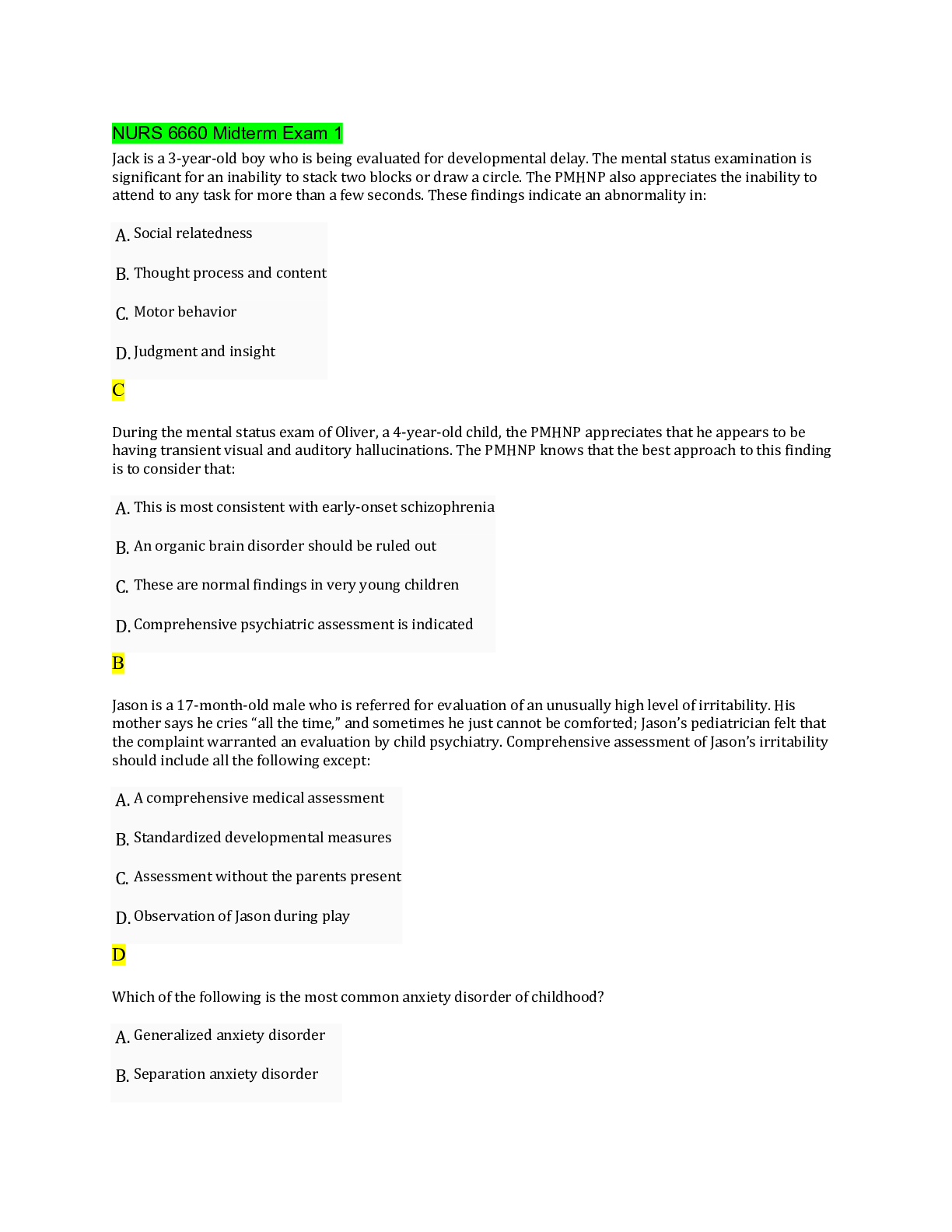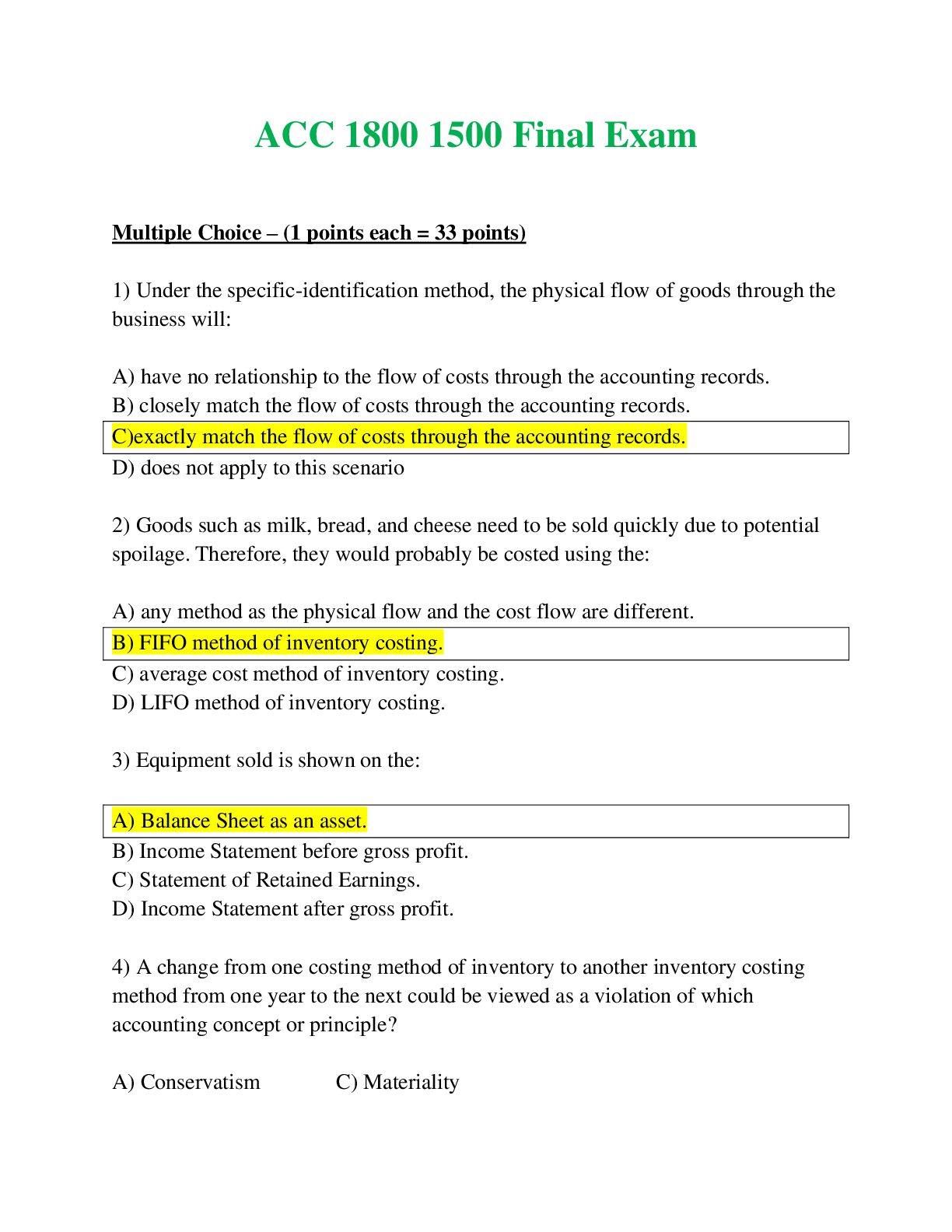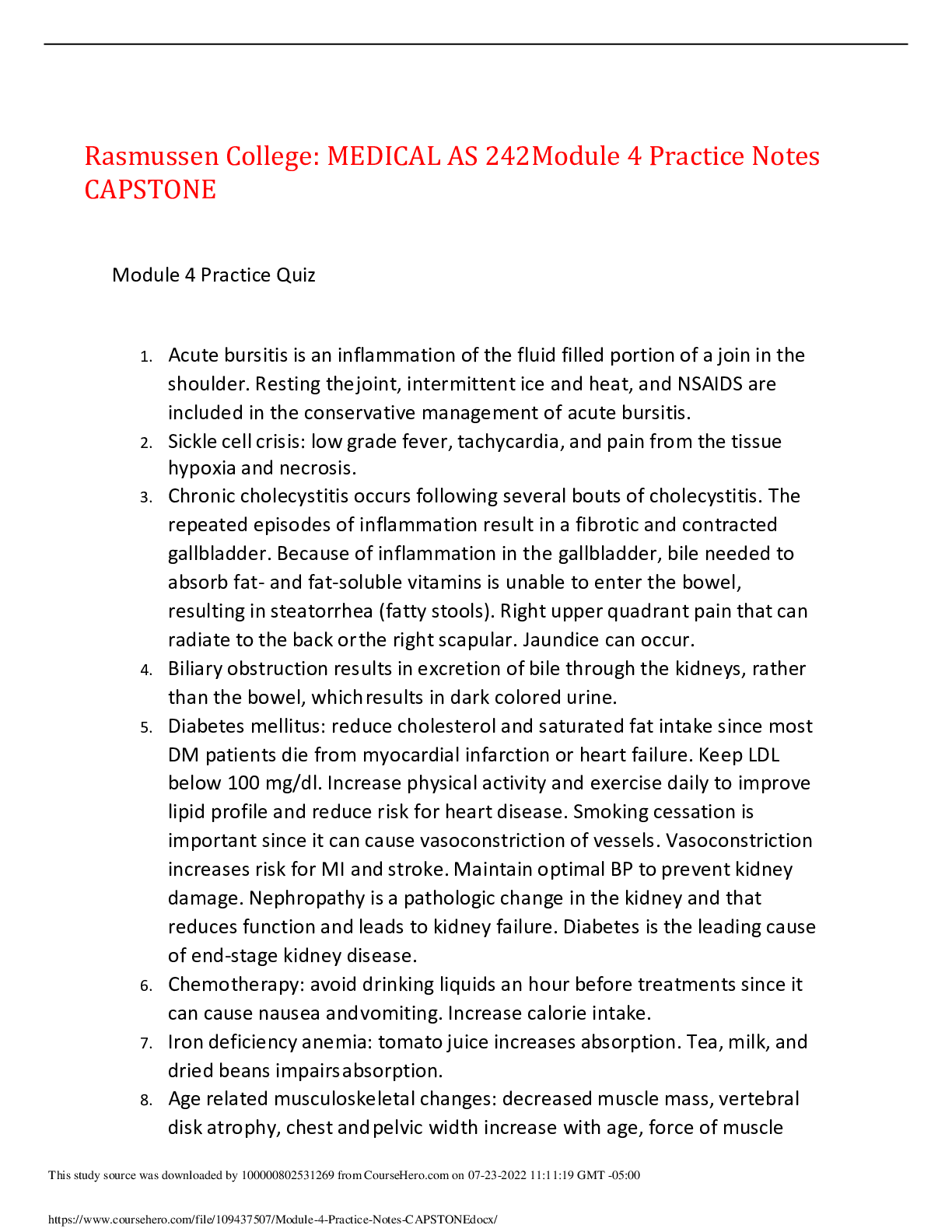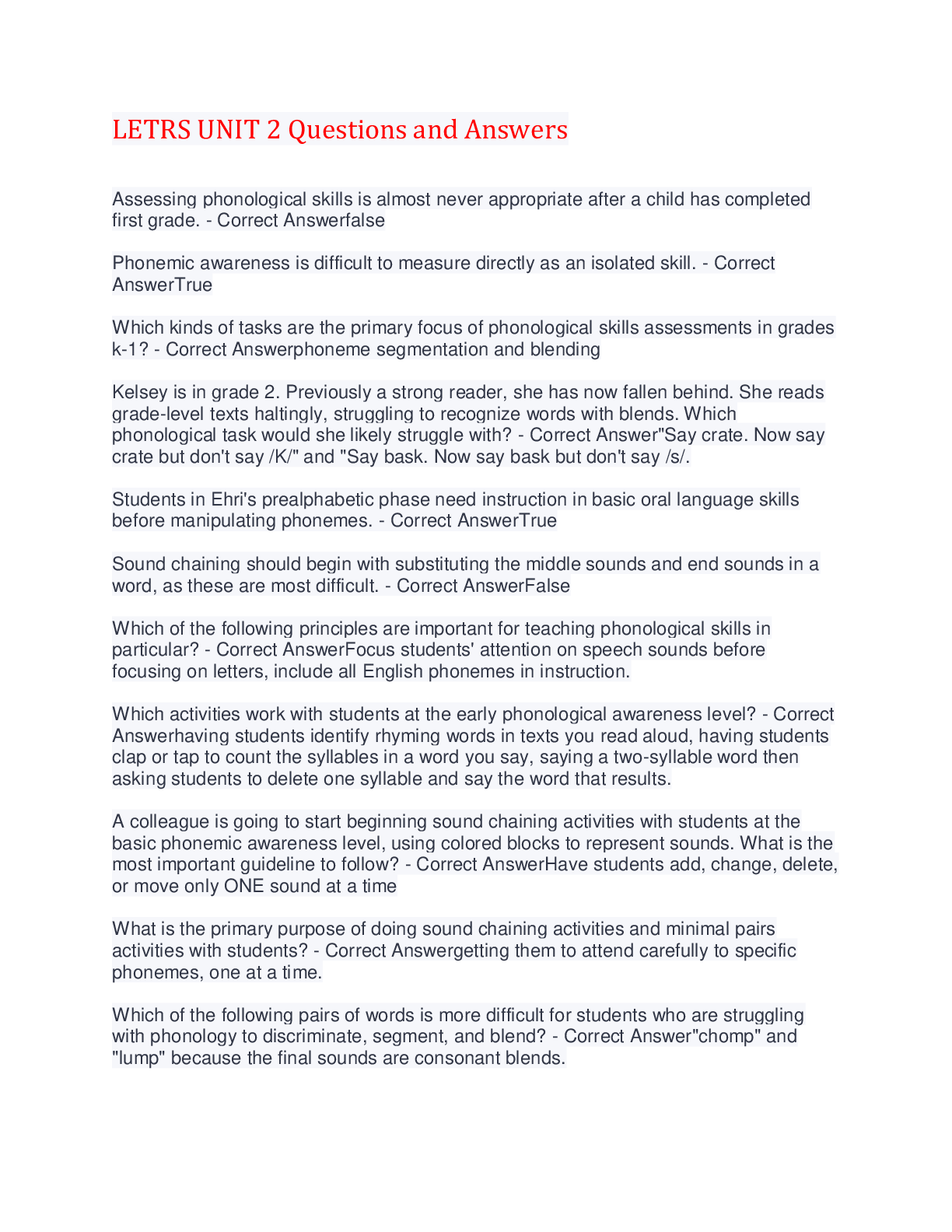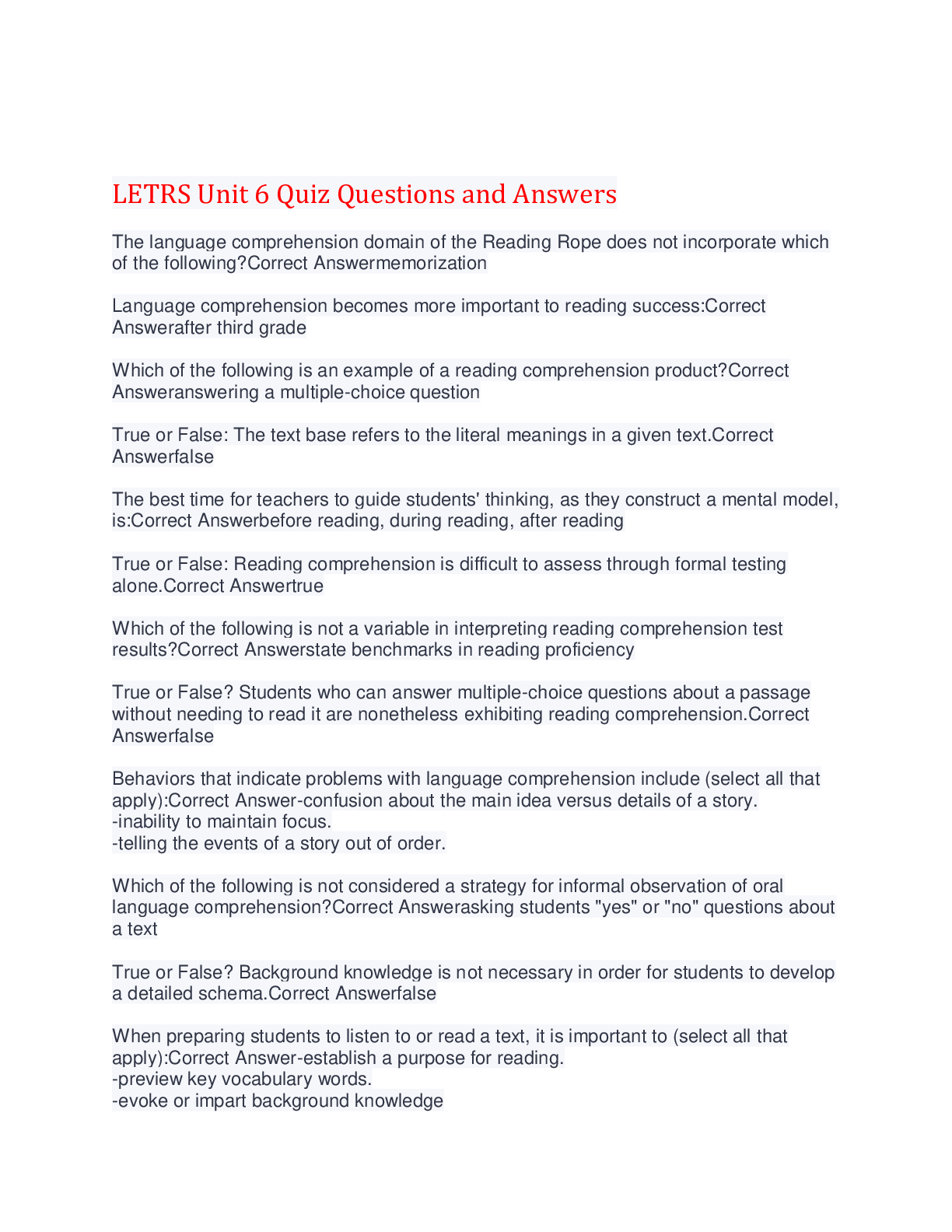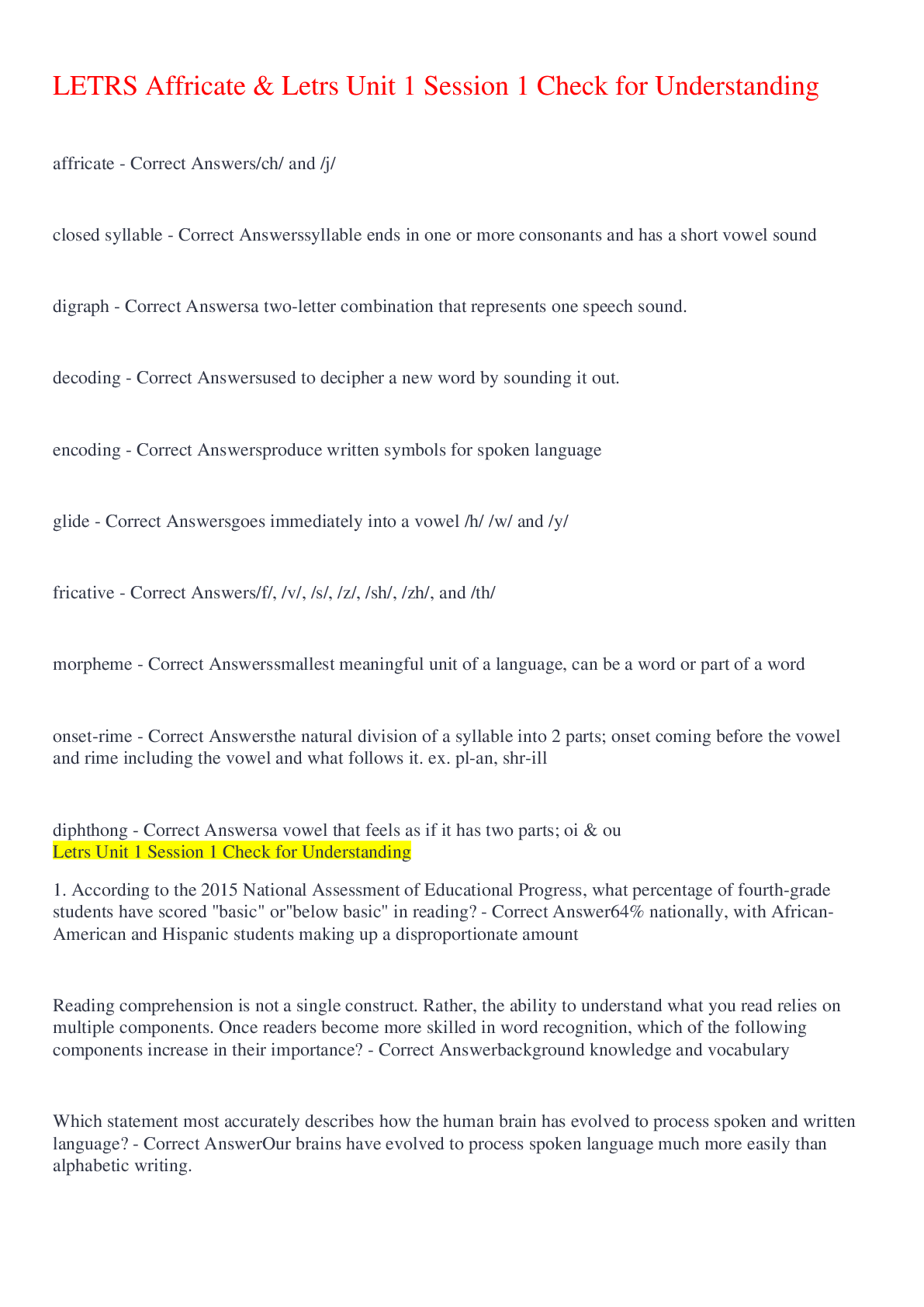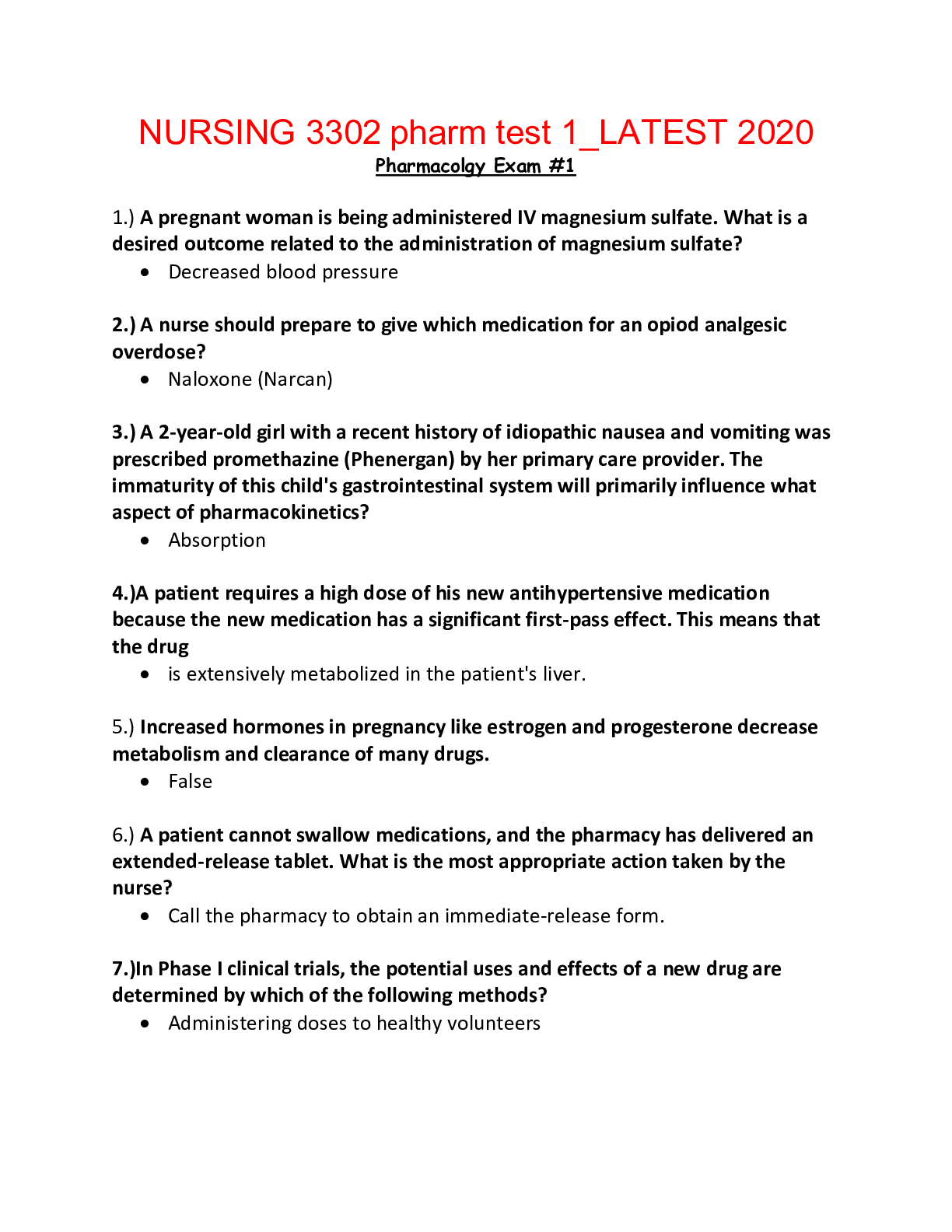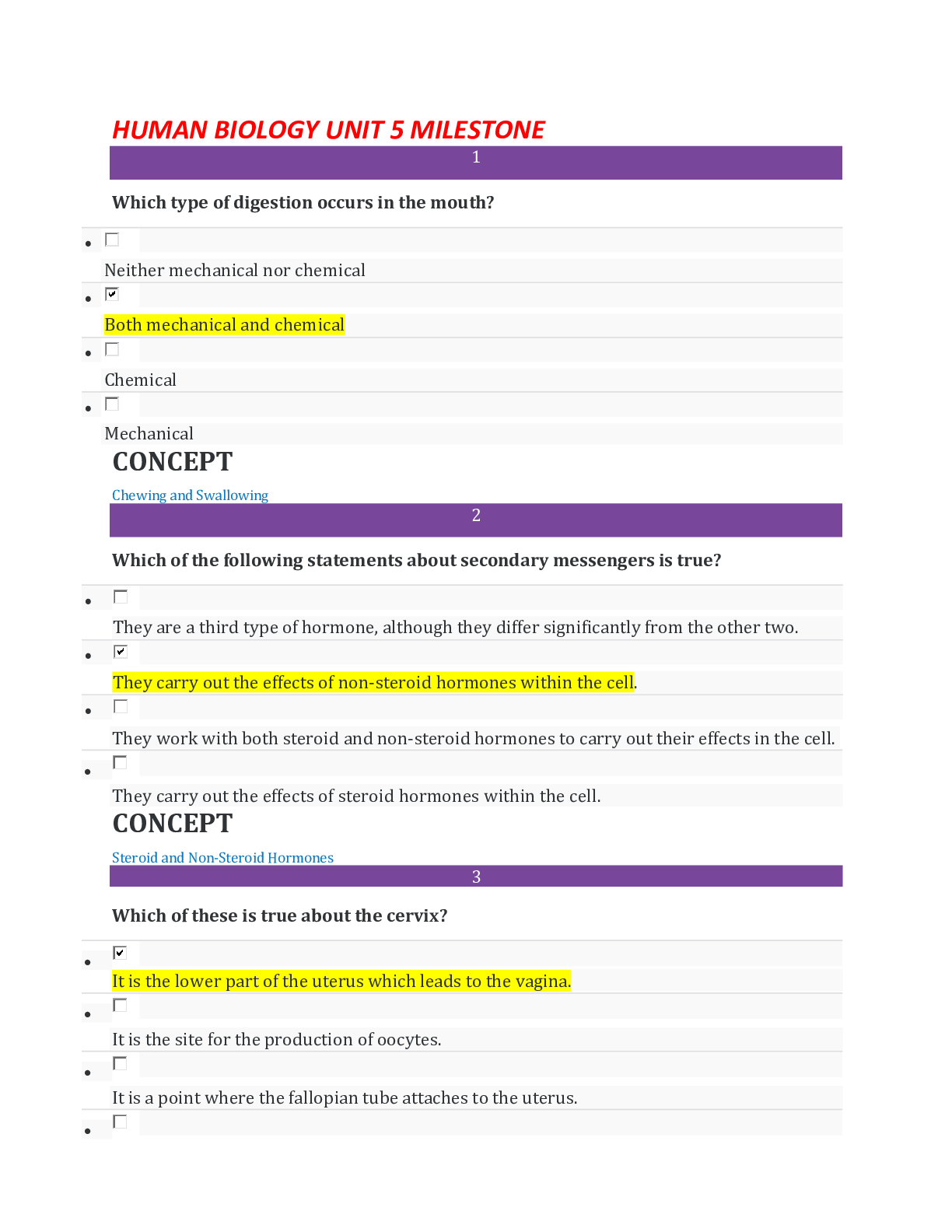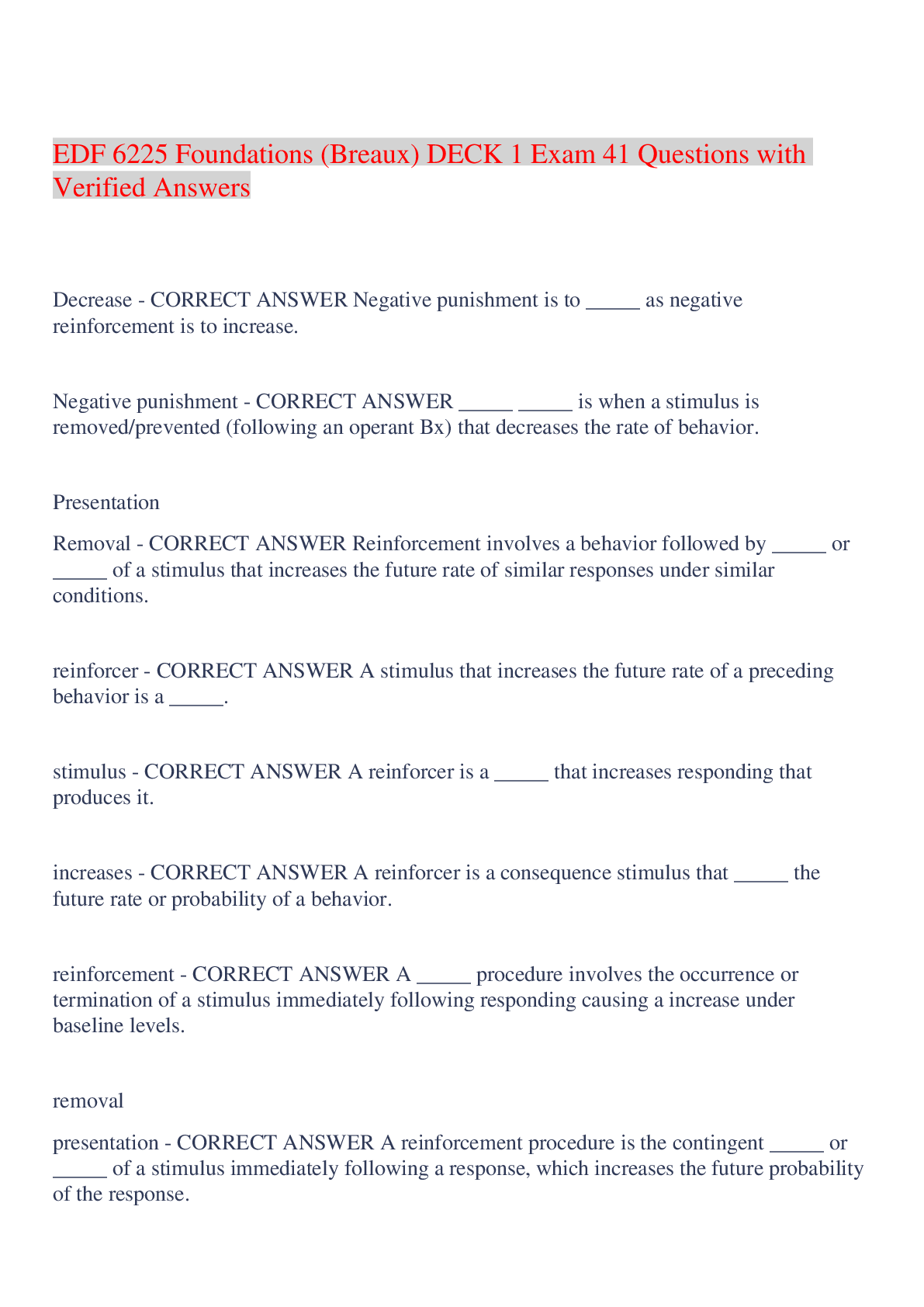NURS 3180 ATI MATERNAL-NEWBORN 1,2& 3_LATEST ,100% CORRECT
Document Content and Description Below
. Two days after delivery, a postpartum client prepares for discharge. What should the nurse teach her about lochia flow? 2. A nurse monitors fetal well-being by means of an external monitor. At the... peak of the contractions, the fetal heart rate has repeatedly dropped 30 beats/min below the baseline. Late decelerations are suspected and the nurse notifies the physician. Which is the rationale for this action? 3. Which preoperative nursing interventions should be included for a client who is scheduled to have an emergency cesarean birth? 4. Which nursing instruction should be given to the breastfeeding mother regarding care of the breasts after discharge? 5. A client in preterm labor is admitted to the hospital. Which classification of drugs should the nurse anticipate administering? 6. Which of the following are probable signs, strongly indicating pregnancy? 7. Two hours after delivery the nurse assesses the client and documents that the fundus is soft, boggy, above the level of the umbilicus, and displaced to the right side. The nurse encourages the client to void. Which is the rationale for this nursing action? 8. Which site is preferred for giving an IM injection to a newborn? 9. During the first twelve hours following a normal vaginal delivery, the client voids 2,000 mL of urine. How should the nurse interpret this finding? 10. If a pregnant client diagnosed with gestational diabetes cannot maintain control of her blood sugar by diet alone, which medication will she receive? 11. Which assessment finding indicates that placental separation has occurred during the third stage of labor? 12. The nurse midwife is concerned about a pregnant client who is suspected of having a TORCH infection. Which is the main reason TORCH infections are grouped together? They are: 13. During the postpartum period, a hospitalized client complains of discomfort related to her episiotomy. The nurse assigns the diagnosis of “pain related to perineal sutures.” Which nursing intervention is most appropriate during the first 24 hours following an episiotomy? 14. A client asks the nurse about the benefits of breastfeeding. Which response by the nurse provides the most accurate information? 16. A client delivered two days ago and is suspected of having postpartum "blues." Which symptoms confirm the diagnosis? 17. Shortly after delivery, the nursery nurse gives the newborn an injection of phytonadione (Vitamin K). The infant's grandmother wants to know why the baby got “a shot in his leg.” Which response by the nurse is most appropriate? 18. At 10 weeks gestation, a primigravida asks the nurse what is occurring developmentally with her baby. Which response by the nurse is correct? 19. A nurse in the clinic instructs a primigravida about the danger signs of pregnancy. The client demonstrates understanding of the instructions, stating she will notify the physician if which sign occurs? 20. An hour after delivery, the nurse instills erythromycin (Ilotycin) ointment into the eyes of a newborn. The main objective of the treatment is to prevent infection caused by which organism? 21. A woman in active labor receives a narcotic analgesic for pain control. If the narcotic is given a half an hour before delivery, which effect will the medication have on the infant? It will cause the infant's: 22. For a client in the second trimester of pregnancy, which assessment data support a diagnosis of pregnancy-induced hypertension (PIH)? 23. A 35-week gestation infant was delivered by forceps. Which assessment findings should alert the nurse to a possible complication of the forceps delivery? 24. In which position should the nurse place the laboring client in order to increase the intensity of the contractions and improve oxygenation to the fetus? 25. A woman enters the birthing center in active labor. She tells the nurse that her membranes ruptured 26 hours ago. The nurse immediately takes the client's vital signs. Which is the rationale for the nurse's actions? 26. A new client's pregnancy is confirmed at 10 weeks gestation. Her history reveals that her first two pregnancies ended in spontaneous abortion at 12 and 20 weeks. She has a4-year-old and a set of 1-year-old twins. How should the nurse record the client's current gravida and para status? 27. A 16-year-old client reports to the school nurse because of nausea and vomiting. After exploring the signs and symptoms with the client, the nurse asks the girl whether she could be pregnant. The girl confirms that she is pregnant, but states that she does not know how it happened. Which nursing diagnosis is most important? 28. A client is admitted to the hospital for induction of labor. Which are the main indications for labor induction? 29. A client in active labor receives a regional anesthetic. Which is the main purpose of regional anesthetics? 30. The nursery nurse reviews a newborn's birth history and notes that the Apgar scores were 5 at one minute after birth, and 7 at five minutes after birth. How should the nurse interpret these scores? The infant: 31. With routine prenatal screening, a woman in the second trimester of pregnancy is confirmed to have gestational diabetes. How may the nurse explain the role of diet and insulin in the management of blood sugar during pregnancy? 32. A breastfeeding mother complains of cramping. Which is the main cause of the client's afterpains? 33. A client who is 37 weeks gestation comes to the office for a routine visit. This is the client's first baby and she asks the nurse how she will know when labor begins. Which signs indicate that true labor has begun? 34. A multiparous woman with a history of all vaginal births is admitted to the hospital in labor. After several hours, the client's labor has not progressed and she is getting tired and restless. The decision is made to proceed with cesarean delivery. The nurse recognizes the client's knowledge deficit regarding the surgical delivery and care afterbirth. Which is the appropriate expected outcome for correction of the client's knowledge deficit? The client will: 35. The physician performs an amniotomy for a woman in labor. Which nursing action should follow the procedure? 36. For a pregnant adolescent who is anemic, which foods should the nurse include In the client's dietary plan to increase iron levels? 37. Which condition must occur in order for identical (monozygotic) twins to develop? 38. Which fetal structure is responsible for carrying oxygenated blood from the placenta to the fetus? 39. A client at 33 weeks gestation is admitted for suspected abruptio placenta. Which factor in the client's history supports this diagnosis? The client states that she: 40. Which explanation is most appropriate when describing physiological jaundice to the parents of a newborn? 41. A woman at 42 weeks gestation enters the hospital for induction of labor. Since the infant is postterm, which complications should the nurse anticipate when planning for the delivery? 42. Which method of temperature regulation would safely and effectively prevent cold stress in a newly delivered infant? 43. The nurse performs Leopold's maneuvers for a client admitted in labor. Which is the main goal of Leopold's maneuvers? 44. Immediately after birth, the nurse places the newborn under a radiant warmer. Which is the primary rationale for the nurse's action? 45. A client, gravida 1, para 0, in active labor, is becoming increasingly anxious. Which statement by the nurse will block therapeutic communication with the client? 46. A nurse prepares to teach a class regarding postpartum care and includes infections in the teaching plan. Which is the main cause of mastitis in the postpartum client? 47. A postterm infant is delivered by cesarean section because of fetal distress and meconium-stained amniotic fluid. The nursery nurse frequently monitors the baby's respiratory rate, observing for tachypnea. Which is the reason for the nurse's actions? The infant may: 48. The nurse notices a variable deceleration on a fetal monitor strip. Which nursing action is appropriate? 49. The nursery nurse delays the first bottle feeding of a newborn. Which is the most common reason for the nurse's actions? The infant has: 50. During active labor, after a sudden slowing of the fetal heart rate, the nurse assesses the woman's perineum and observes a prolapsed cord. Which nursing action is most appropriate? 51. A client is in the latent stage of labor. Which nursing intervention is most appropriate? 52. Which conditions create a risk for uterine atony in the immediate postpartum period? 53. A client at ten weeks gestation tells the nurse that she has been having “morning sickness.” The nurse advises the client to eat foods that are easy to digest and low in fat. Which is the rationale for the nurse's instruction? 54. Which information is most important for the nurse to gather when a client is admitted to the unit in labor? 55. The nurse conducting a physical assessment notes that a 1-day-old newborn with dark skin has a bluish-gray discoloration over the lower back, the buttocks, and the scrotum. How should this assessment finding be documented? 56. A small-for-gestational-age infant is irritable and jittery, and has hyperreflexia and clonus. He is jaundiced, has temperature instability, and spitty after feedings. The nurse suspects the infant is displaying signs of passive addiction during pregnancy. When planning for the infant's care at home, which nursing assessment is most important for the infant experiencing neonatal abstinence syndrome? 57. A woman in active labor is admitted to the labor and delivery unit, accompanied by her partner. As labor progresses, the nurse notes he is not interacting with the woman and sits in the corner, looking out the window. How may the nurse understand the man's actions? 58. A client is admitted to the hospital with severe pregnancy-induced hypertension (PIH). The physician orders magnesium sulfate. Which nursing intervention is important when administering this drug? 59. A 27-week gestation infant is taken to a newborn intensive care unit 150 miles away. Initially, which emotion should the nurse expect the mother to display after the transfer? 60. A 38 week gestation newborn weighs 4020 grams, is sluggish, and has limp muscle tone. The baby experienced a broken clavicle during delivery. Based on this information, which can the nurse conclude about the baby? 61. Which assessment finding suggests thrombophlebitis in a postpartum client? 62. A client comes to the clinic to confirm that she is pregnant. Her last menstrual period was January 31st. According to Naegele's rule, when should the client expect to deliver? 63. Which procedure should be avoided for the client known to have a placenta previa? 64. A woman in the first trimester comes to the clinic with vaginal bleeding. The physician determines that the fetus has died and that the placenta, fetus, and tissues still remain in the uterus. How should the findings be documented? 65. A woman in the transition stage of labor is using paced breathing to relieve pain. She complains of blurred vision, numbness, and tingling of her hands and mouth. Which condition is indicated by these signs and symptoms? 66. Which data support a diagnosis of abruptio placenta in a pregnant woman? 67. A women in her first trimester contracts rubella. How is the fetus likely to be affected? 68. An hour after delivery, a 4000 gram infant exhibits pallor, jitteriness, a blood sugar level of 40 gm/dL, irritability and periodic apnea. Which maternal condition could be the cause of the newborn's symptoms? 69. A client delivered vaginally six hours ago. Which assessment finding can be interpreted as normal? 70. A new mother receives instructions about care of her newborn son's circumcision. Which statement made by the mother indicates that further teaching is needed? 71. A 17-year-old client delivered her first baby 8 hours ago. Which of the following is an indication that appropriate bonding is occurring? The client: 72. A new mother is crying in her room. She tells the nurse that her new baby boy has enlarged breasts and she thinks that there is something wrong. How should the nurse respond? 73. During the active phase of labor, the membranes rupture and the nurse notes green amniotic fluid. Which nursing action should be initiated immediately? 74. At 28 weeks gestation, a woman enters the hospital in preterm labor and receives atocolytic medication to stop labor. Which assessment findings should be reported immediately to the physician? 75. A labor and delivery nurse suspects that a client is in the transition stage of labor. Which information supports this conclusion? The client is: ATI. CHILD CARE 2.0 1 The parents of a 5-month-old infant state that their infant seems to eat very little. Most of the food comes out of the infant's mouth and onto his clothes. Which of the following explanations should the nurse give to the parents? 2 A nurse smells an odor identified as marijuana coming from a room. Which of the following client findings would confirm inhalation of the substance? 3 A nurse is checking children at an orthopedic outpatient setting. Which of the following should the nurse expect to see as manifestations of scoliosis? 4 A nurse is providing client/patient education to the mother of an 8-year-old child diagnosed with B-hemolytic streptococci infection (strep throat). The nurse emphasizes the importance of promptly starting and completing the entire course of antibiotics. The mother asks why this is important. The nurse states that the antibiotic will 5 A nurse is reinforcing teaching about accidental poisoning to a parent during a routine well-child visit. The nurse asks the parent, "What would be your first response if your child accidentally took an overdose of acetaminophen (Tylenol)?" Which of the following statements by the parent would indicate a correct understanding? 6 A nurse is caring for a 23-month-old child with iron-deficiency anemia. The parents indicate they have been taught about the diagnosis, but are concerned that they are not doing all that they need to do. Which of the following should the nurse include when reinforcing teaching? 7 A nurse is reviewing discharge teaching with the parents of a child who has pediculosis. Which of the following should the nurse include in the teaching? 8 A nurse is caring for a toddler who is in an oxygen tent. Which of the following actions should the nurse take in order to promote comfort while maintaining the child's safety? 9 A nurse is reinforcing teaching with the parent of a child with a urinary tract infection. Which of the following statements made by the parent indicates understanding of how to prevent future infections? 10 A nurse is reviewing discharge instructions with the parent of an infant who has acute laryngotracheobronchitis (croup). Which of the following statements made by the parent indicates a need for further teaching? 11 A 15-year-old client visits the clinic to get medical clearance to play a sport. The nurse reviews measures to prevent athlete's foot with the client. Which of the following statements by the client indicates that the instructions were understood? 12 A nurse is collecting data on a 3-year-old child with eczema in an outpatient center. The parent asks whether any changes can be made at home to prevent the recurrence of eczema. Which of the following is an appropriate response by the nurse? 13 A nurse is caring for a 7-year-old child who is admitted with an asthma exacerbation. This is the third admission since diagnosis 6 months ago. Which of the following topics should be reinforced with the parents and child in order to prevent future readmissions? 14 Which of the following physical manifestations of a client with anorexia nervosa best indicates compliance with the treatment plan of care? 15 An assistive personnel (AP) is caring for a child diagnosed with leukemia and undergoing chemotherapy. In which of the following clinical situations should a nurse intervene? 16 A nurse is preparing to administer an intramuscular (IM) injection to a 2-month-old infant. Which of the following is the preferred injection site? (PICTURE HERE) 17 A nurse is reinforcing teaching with the parent of an infant who has club feet with bilateral casts. Which of the following statements should be included in the teaching? 18 A nurse is caring for a child with measles. Which of the following actions is appropriate supportive care? 19 A nurse is caring for a 14-year-old client diagnosed with diabetes mellitus. The nurse is discussing the ongoing monitoring needed with this diagnosis. Which of the following should be included in the discussion? 20 A nurse is reinforcing teaching with the parent of a 4-year-old child with influenza. Which of the following should the nurse include in the teaching? 21 A nurse is discussing nutrition with an adolescent who is pregnant. The adolescent's parent is in the room. Which of the following statements made by the parent indicates a need for further dietary instruction? 22 A nurse is caring for a 14-year-old child with appendicitis who has a pain rating of 8 on a scale of 1 to 10. The child has just returned to the unit after a computed tomography (CT) scan of the abdomen and tells the nurse the pain just stopped. Which of the following should the nurse do first? 23 A nurse is monitoring a 9-year-old child on the first postoperative day following abdominal surgery. The nurse notes the child grimacing and guarding her abdomen. Which of the following pain assessment tools should the nurse use based on its acceptance by children? 24 A nurse is reinforcing teaching to a group of parents about preventing accidental poisoning in preschoolers. Which of the following should the nurse include? 25 A nurse is caring for a 4-month-old infant with thrush (candidiasis) who is breastfed. Which of the following is an appropriate nursing action? 26 A nurse is caring for an adolescent with inadequate weight gain. Which of the following nutritional considerations is important to reinforce when talking with the client about appropriate nutrition? 27 A primary care provider prescribes amoxicillin suspension to a child with otitis media who weighs 22 lb. The prescription reads: 30 mg/kg/day in divided doses every 8 hr. The pharmacy carries the medication as 200 mg/5 mL. How may mL should the nurse give in one dose? 28 Which of the following approaches is the most accurate way to measure the heart rate of a 10month-old infant? 29 A nurse is caring for a 4-year-old child diagnosed with leukemia who is admitted with myelosuppression. Which of the following actions should the nurse take? 30 The parents of a 4-year-old child state that they had an infant die 2 months ago during childbirth. They are concerned about their 4-year-old child's response to the infant's death. Which of the following statements by the parents indicates an expected response about death from the 4-year-old child? 31 A nurse is preparing a room for the admission of a client with sickle cell anemia who is in vasoocclusive crisis. Which type of equipment should the nurse place in the client's room? 32 An 8-year-old child is admitted to a pediatric unit with a fractured femur and is placed in skeletaltraction. Which of the following nursing interventions is the most appropriate? 33 A nurse on a pediatric unit is assigned to care for a child with Reye syndrome. Which of the following is the most serious clinical manifestations for which the nurse should monitor? 34 A nurse is preparing to take a rectal temperature on a 7-month-old infant. Which of the following should the nurse keep in mind when preparing to take the temperature? 35 A nurse is talking to the parents of a 3-year-old child about water safety precautions. Which of the following statements made by the parents indicates a need for clarification? 36 A nurse is caring for a child with Wilms' tumor. The parents ask why the sign "Do not palpate the abdomen" has to be placed on their child's bed. Which of the following is the correct response by the nurse? 37 A nurse is caring for a child with muscular dystrophy. Which of the following priority actions should the nurse include in the care of this child? 38 A nurse is caring for a child with acute glomerulonephritis. The child has edema, hypertension, and gross hematuria. Which of the following is the most appropriate nursing intervention? 39 A nurse is performing a routine physical examination on an adolescent client who asks, "Why do I have to use a condom if my girlfriend is on the pill? I thought the pill was enough protection against pregnancy." Which of the following is the most appropriate response by the nurse? 40 A nurse is preparing to admit a 15-year-old client with HIV/AIDS. Based on the client's diagnosis, which of the following nursing actions is appropriate? 41 A nurse is reinforcing home care instructions with the parents of a 5-year-old child who has acute bronchitis. In order to prevent the transmission of the virus, which of the following should the nurse include in the instructions? 42 A nurse is monitoring a 6-month-old infant who is diagnosed with pneumonia. The nurse observes an absence of respirations and peripheral cyanosis. After determining unresponsiveness, which of the following is the next nursing action? 43 Which of the following emotional manifestations demonstrates an improvement in a 7-month-oldinfant diagnosed with nonorganic failure to thrive? 44 During an outpatient clinic visit a 13-year-old client is diagnosed with infectious mononucleosis. The nurse should expect which of the following to be included in the client's plan of care? 45 A nurse is reinforcing teaching with the parents of an infant diagnosed with recurrent otitis media. Which of the following is appropriate teaching to include? 46 A nurse is caring for a child who has hemophilia. The nurse should expect abnormal results in which of the following diagnostic tests? 47 A nurse is caring for a 4-year-old child who is prescribed an intravenous medication preoperatively. Which of the following therapeutic play techniques is most appropriate when reinforcing the teaching for this procedure? 48 A nurse is monitoring a child whose parents are suspected of child neglect. Which of the following is an expected finding of neglect? 49 A nurse is initiating a plan of care for a toddler who is hospitalized. Which of the following instructions is important to communicate to the nursing assistant? 50 A nurse is caring for a 3-year-old child with strabismus. Which of the following actions should the nurse advise the parents to implement to help prevent amblyopia? 51 A nurse is caring for an infant with a history of vomiting due to gastroenteritis. Which of the following nursing interventions is considered the priority? 52 A nurse has reinforced teaching to the parent of a 9-month-old infant who has redness in the diaper area and inner thighs. Which of the following statements by the parent indicates a correct understanding of this teaching 53 A 6-year-old child is brought to the emergency department after falling down the outdoor steps. The parent's account of the incident appears different than the neighbor's account of the incident. Upon questioning the child, the nurse should recognize which of the following as usual pattern of behavior exhibited by an abused child? 54 A nurse is providing care for a 2-day-old neonate with a cleft lip and palate. The nurse evaluates the parents' understanding of correct feeding methods. Which of the following observations indicates a need for further teaching? 55 A nurse is holding an infant during a lumbar puncture for a suspicion of meningitis. The infant is in a sitting position with the buttocks at the edge of the table and the neck flexed, and the nurses is immobilizing the infant's arms and legs. Which assessment takes priority during the procedure? 56 A nurse is reinforcing teaching given to the parent of a 1-year-old child who has had a high temperature, vomiting, and diarrhea for 48 hr. The child has sunken eyes and cracked lips. Which of the following should the nurse tell the parent? 57 A nurse is caring for a 4-year-old client with full-thickness burns. Which of the following nursing actions are essential for the care of this child? (Select all that apply.) 58 A nurse is caring for a 7-month-old infant with acute bronchiolitis. The infant has a persistent, dry, hacking cough that worsens at night, tachypnea, and weakness. Which of the following actions should the nurse implement? 59 A nurse is caring for an infant with hypospadias. Which of the following is an expected finding? 60 A nurse is caring for a 3-year-old child who is diagnosed with a urinary tract infection (UTI). The parent is concerned about recognizing the signs and symptoms of future UTIs. Which of the following statements made by the parent indicates a correct understanding of the manifestations of a UTI? ATI.CHILD CARE 1.0 1 A child diagnosed with asthma begins corticosteroid treatments. The nurse explains to the parents that the purpose of corticosteroid treatment is to produce which therapeutic effect? 2 Which is the recommended treatment for moderate to severe lead poisoning? 3 Which treatment is a nursing priority when providing care for an infant diagnosed with bacterial meningitis? 4 The dosage of a pediatric medication is 120mg/kg/day to be give t.i.d. The patient weighs 12 pounds. What is the correct dose for the nurse to administer? 5 In a child diagnosed with Tetralogy of Fallot, which of the following is a compensatory mechanism to decrease venous return to the heart? 6 A 1-year-old receives routine health maintenance care at the pediatric clinic. The child receives an MMR immunization. The mother asks the nurse, "When will my child get the next dose of MMR vaccine?" Which is the correct response by the nurse? 7 Which is a major difference in the clinical manifestation of adolescents with anorexia nervosa compared to bulimia? 8 Which is the most common factor associated with non-organic failure to thrive? 9 An adolescent recovering from substance abuse is diagnosed with hepatitis B. Which nursing instruction should be included when planning the client's care? 10 Changes in the growth and development of the preschooler are characterized by: 11 A teacher asks the school nurse to assess the behavior of a child with attention deficit-hyperactivity disorder (ADHD). Which situation best facilitates an effective nurse/child interaction? 12 The health care provider orders 60% oxygen to be administered with a partial rebreather mask and bag reservoir. Which error regarding the oxygen delivery system requires correction? 13 A toddler is admitted to the hospital for treatment of acute gastroenteritis and dehydration. The mother states that she must go home to make arrangements for the care of her other children. To reduce the child's separation anxiety, which nursing intervention is most appropriate? 14 Which technique is most appropriate when assessing the circulation of a child's leg in traction? 15 Initially, which solid food is generally recommended for an infant's diet? 16 A boy diagnosed with hemophilia falls while roller-blading and injures his knee. The nurse is most likely to assess which physical finding? 17 A toddler is admitted to the emergency department following a febrile seizure. Which information does the nurse provide to the family regarding febrile seizures? 18 The nurse assesses Koplik spots on the lingual and buccal mucosa of a 4-year-old. Which disease is likely to appear within the next two to three days? 19 Which is the most appropriate pain scale to use for a Spanish speaking 5-year-old child who communicates very little in English? 20 If a child with Type I diabetes mellitus takes regular insulin at 0800, which time during the day should the parents be taught to expect the peak action of regular insulin? 21 The nurse evaluates the effectiveness of care for the school-aged child with juvenile rheumatoid arthritis (JRA). Which clinical outcome does the nurse expect the child to demonstrate after nursing care interventions are implemented? 22 The nurse providing care to the child with pediculosis capitus (head lice) educates the family about the condition, transmission, and treatment. Which condition is necessary for survival of the louse on the host? 23 An adolescent with Type I diabetes mellitus asks her mother for permission to go with friends to get pizza and ice cream. Which response by the adolescent's mother indicates that previous nursing instruction has been effective? 24 When obtaining a health history, which significant event may precede a diagnosis of rheumatic fever? 25 Which intervention is most appropriate when providing nursing care for the child diagnosed with Duchenne's muscular dystrophy? 26 An adolescent comes to the clinic with a fever, sore throat, and fatigue. Physical assessment findings reveal enlargement of the spleen and lymph nodes. Mononucleosis is diagnosed. Which is the nurse's priority in planning the care for the child at home? 27 The presence of which classic cell provides data for the definitive diagnosis of Hodgkin's disease? 28 Which is the most common complication of acetaminophen toxicity in the toddler? 29 During the acute phase of glomerulonephritis in a child, which intervention is the most appropriate? 30 An 18-year-old female diagnosed with systemic lupus erythematosus (SLE) comes to the rheumatology clinic for a follow-up visit. The nurse assesses the client's skin and reviews the client's BUN and creatinine levels. Which is the rationale for the nurse's actions? 31 At an unscheduled clinic appointment, the mother of a 9-month-old states that she is concerned about her baby's small size and frequent crying. The mother has limited support systems and poor role modeling for parenthood from her own childhood. Which initial physical assessment data is most important for the nurse to obtain at this time? 32 Which information regarding suspected episodes of child abuse should the nurse include in the documentation? 33 A toddler is diagnosed with impetigo and the nurse gives the toddler's mother instructions about skin care. Which statement by the mother indicates a need for further education? 34 The nurse provides nutritional education for the mother of a toddler. Which information in the toddler's health history indicates a problem regarding nutrition? The toddler: 35 During the mental health examination of a troubled teen, the nurse assesses for the risk of violence. Which nursing response is most appropriate? 36 A physician orders gentamicin (Garamycin) one drop OS four times daily for a 3-year-old child. Which method of medication administration is most appropriate? 37 A school-age client receives a blood transfusion. The nurse assesses shortness of breath, bulging neck veins, and a moist cough. These findings are indicative of which complication? 38 The nurse plans the preoperative care of the infant with pyloric stenosis. In feeding the infant, which measure should be implemented until surgery? 39 When providing instructions to a day care provider about the transmission of chickenpox, which statement by the day-care worker reflects a need for further education about the infectious phase of this disease? 40 Digoxin (Lanoxin) is used in the treatment of a client diagnosed with a congenital heart defect. Which is the mechanism of action? 41 The nurse provides care for the child diagnosed with glomerulonephritis and collects a urine sample for urinalysis. Which urine color suggests the presence of red blood cells? 42 A 2-month-old baby is diagnosed with cystic fibrosis. Which statement most accurately defines this disorder? 43 Initial treatment for unilateral (talipesequinus) clubfoot includes which intervention? 44 A 10-year-old is seen in the allergy clinic. The child describes itchy, watery eyes and nasal congestion after spending time outdoors. The skin is noted to be dry and scaly in patches on the back of the arms. Skin testing is ordered. Which measure by the nurse promotes the accuracy of the testing? 45 A school-age child falls from a bicycle and sustains head trauma. Upon arrival to the emergency department, the nurse identifies signs indicating increased intracranial pressure. Which sign should the nurse document? 46 According to Erikson's theory of child development, the normal school-aged child masters which psychosocial stage for development of healthy personality? 47 A preschool child is brought to the primary-care clinic because of anal itching at night. The child is diagnosed with pinworm infestation and mebendazole (Vermox) is prescribed. Which instruction to the family is most important regarding follow-up care? 48 A nurse assesses the growth and development of a 3-month-old. Which activity is undeveloped at this age? 49 Which diagnostic procedure is used to ascertain if a female client has gonorrhea? 50 The nurse assesses the development of a 3-year-old child at a routine clinic visit. The nurse should expect the mastery of which developmental task? 51 The nurse providing nutritional instruction to parents of a child diagnosed with cystic fibrosis recommends which type of diet? 52 Which nursing assessment indicates bleeding in the postoperative phase after a tonsillectomy? 53 The school nurse provides an educational program for a group of preadolescents regarding the use of birth control pills. Which is the mechanism of action for oral contraceptives? 54 The mother of a school-aged child diagnosed with a terminal illness asks the nurse, “How should I explain this to my child?” Which nursing instruction is most appropriate? 55 The nurse prepares to administer an intramuscular injection to a 4-year-old child. Which site is most appropriate? 56 Which is the peak age for the occurrence of sudden infant death syndrome (SIDS)? 57 An adolescent seeks health care at a free clinic and states she is sexually active and concerned about AIDS. Which nursing instruction regarding transmission of sexually transmitted diseases is most appropriate? 58 An adolescent girl is diagnosed with scoliosis and her mother is reluctant to pursue treatment. The nurse educates the mother that untreated scoliosis may ultimately have which outcome? 59 When assessing the heart rate for infants and small children, which pulse point should the nurse use? 60 A hospitalized 18-month-old is diagnosed with gastroenteritis. When providing discharge teaching for the child's parents, which food should the nurse suggest be reintroduced last? Incorrect: Bananas can be introduced into the diet early and are part of the BRAT diet. Bananas provide potassium, which may have been lost through vomiting and diarrhea. 61 A child with Type I diabetes mellitus experiences polyuria, polydipsia, and polyphagia, and has a history of diabetic ketoacidosis. The family should be instructed that ketones can appear in the urine when the blood glucose reaches which level? 62 A hospitalized preschool child is recovering from surgery and is in the playroom. Which behavior should the nurse expect to observe? 63 A 4-week-old infant with an atrial septal defect (ASD) is monitored for signs of congestive heart failure (CHF) prior to surgery. The nurse measures intake and output to determine the fluid status of the child. Which is the best method to obtain an approximation of the volume of urine output? 64 A 12-week-old infant requires the insertion of a ventricular peritoneal (VP) shunt for the treatment of hydrocephalus. Which is the most serious complication of VP shunts? 65 A mother brings her toddler into the clinic because of fussiness, fever, and pulling of the right ear. The mother states that the symptoms are the same as when the child had a previous ear infection. Which is the most appropriate nursing response? 66 An 11-year-old receives an allergy shot during a clinic visit. Which symptom indicates the early stage of anaphylactic shock? 67 When initiating a plan of care for the child with leukemia, the nurse informs the family to anticipate which diagnostic test? 68 The administration of aspirin has been discouraged in pediatric use because of the association of which condition? 69 A child diagnosed with sickle cell disease experiences an acute, vasoocclusive crisis. Which nursing intervention is the priority? 70 The nurse provides discharge instructions to the parent of a child who has a newly applied cast to the leg. Which statement by the parent indicates the need for further nursing instruction? 71 Which is the main difference between the male and female anatomy related to urinary tract infections? 72 A teenage boy commits suicide. Which is the main cause of suicide? 73 Which signs indicate IV infiltration in a child? 74 Following the surgical repair of a toddler's cleft palate, which method of administering fluid is most appropriate in the post-operative recovery period? 75 The nurse planning the care for a child that has partial and full thickness burns understands that an early complication with extensive burns is [Show More]
Last updated: 2 years ago
Preview 1 out of 139 pages

Buy this document to get the full access instantly
Instant Download Access after purchase
Buy NowInstant download
We Accept:

Reviews( 0 )
$20.00
Can't find what you want? Try our AI powered Search
Document information
Connected school, study & course
About the document
Uploaded On
Jan 16, 2021
Number of pages
139
Written in
Additional information
This document has been written for:
Uploaded
Jan 16, 2021
Downloads
1
Views
108


